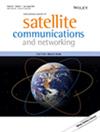Preliminary results on estimation of signal fading on telecommunication satellite telemetry signals with hybrid numerical weather prediction and artificial neural network approach under presence of aerosol effect
Abstract
In this research, an implementation of artificial deep neural networks (ANN) over outputs of 24-h multi-domain high-resolution nested real case Weather Research and Forecasting (WRF) model runs was carried out over two high-resolution simulation domains, which are tested and compared for rainfall generation in order to assess the signal fading event observed on geostationary telecommunication spacecraft in orbit for a real multiscale storm case. Our methodology of ANN, which is driven by WRF model output parameters, focuses on prediction of the rain attenuation signal impairment which is observed on the communication satellite telemetry (TM) downlink signal levels under significant aerosol presence due to dust storm which occurred on 12 September 2020. This modelling approach is then compared to rain attenuation observed on TM signal and correlated with communication satellite ground station TM signal measurements. Preliminary results from conducted error analysis (RMSE) on multiple input single output feed-forward neural network (MISO FFNN) prediction model outputs tested with several neural algorithms indicate good correlation with the TM downlink signal attenuation observations taken from the ground station TM baseband demodulator.


 求助内容:
求助内容: 应助结果提醒方式:
应助结果提醒方式:


